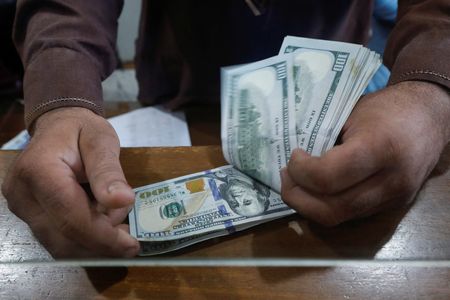By Herbert Lash and Harry Robertson
NEW YORK/LONDON (Reuters) -The dollar rose on Thursday after data showed U.S. import prices increased 0.9% last month, a jump that raised concerns the Federal Reserve’s fight to tame inflation is not yet done and could delay plans for policymakers to cut interest rates.
Economic data this week offered the U.S. central bank good news, but policymakers haven’t openly shifted their views on the timing of rate cuts many investors believe will start this year.
The jump in the price index for U.S. imports in April was the largest one-month increase since it rose 2.9% in March 2022, the Bureau of Labor Statistics said. Prices for U.S. imports last declined on a monthly basis in December, the BLS said.
The market also was grappling with a drop in the number of Americans filing new claims for unemployment benefits last week that pointed to underlying strength in the U.S. labor market. A strong economy could keep rates higher for longer.
“The market is, of course, very sensitive to signs of inflation from wherever it may come, and the import price series that we got today was meaningfully stronger than expected,” said Brain Daingerfield, head of G10 FX strategy at NatWest Markets in Stamford, Connecticut.
“The Fed wants to see consistent progress in more than just one point. The number we got yesterday – the CPI – was not as bad as feared,” he said. “But I don’t think it was enough to materially change the market’s outlook for the Fed and that’s reflected in the way that the dollar has bounced back today.”
The dollar rebounded from a sharp decline against all major currencies on Wednesday when data showed U.S. inflation slowing to 0.3% in April from a month earlier.
The dollar index, which tracks the U.S. currency against six peers, rose 0.27% to 104.47 after a 0.75% slide on Wednesday.
The slowing of consumer prices, after a stall in the first three months of the year, prompted markets to price in the likelihood that the Fed would cut rates twice this year, with the first coming as early as September.
But Fed officials sounded a note of caution on Thursday, with Richmond Fed President Thomas Barkin saying inflation is still not where it needs to be. Holding U.S. central bank policy at current levels will help get still-high inflation back to the 2% target, said Cleveland Fed President Loretta Mester, adding that reaching that goal will take longer than she previously thought.
“The goods price deflation is no longer dominating and then you have the import price number, which went up even though the non-petroleum price didn’t go up a lot,” said Steven Ricchiuto, U.S. chief economist at Mizuho Securities USA in New York.
“The reality is inflation is moderating to 3%. That’s still above target. Maybe you’re jumping the gun on the inflation story,” he said.
Initial claims for state unemployment benefits dropped 10,000 to a seasonally adjusted 222,000 for the week ended May 11, the Labor Department said. Economists polled by Reuters had forecast 220,000 claims in the latest week.
The dollar dropped 1% against the yen on Wednesday but was up 0.28% on Thursday at 155.30, having fallen as low as 153.6 before weak Japanese growth figures dented the yen.
The Japanese currency has fallen around 9.5% this year as the Bank of Japan has kept monetary policy loose while higher Fed interest rates have drawn money towards U.S. bonds and the dollar. The yen has been particularly sensitive to any widening or closing of the interest rate differential.
The euro hit a two-month high at $1.0895 on Thursday before dipping to trade 0.14% lower at $1.0867. Britain’s pound reached a one-month top of $1.2675 before falling back 0.13% to $1.1268.
Bitcoin fell 1.35% to $65,088.
(Reporting by Herbert Lash, additional reporting by Harry Robertson in London and Tom Westbrook in Singapore; Editing by Marguerita Choy, Alexandra Hudson and Jonathan Oatis)










